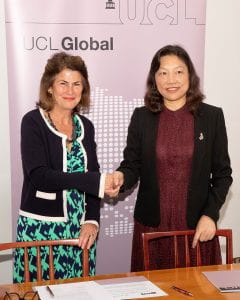Visit from Zheijiang University moves an important archaeological collaboration forward
By Sophie Vinter, on 22 November 2019
In late September 2019, Dame Nicola Brewer, Vice-Provost (International) and Katharine Carruthers, Pro-Vice-Provost (East Asia) met with a delegation from China’s Zhejiang University (ZJU) to sign an expiring Memorandum of Understanding (MoU).
Founded in 1897, Zhejiang University (ZJU) is a prestigious research intensive university in China, located in the city of Hangzhou, about two and a half hours’ drive from Shanghai. With around 55,000 students across 37 colleges and schools, Zheijiang ranks among the top three universities in China. The MoU aims to deepen collaborations between UCL and ZJU in education and research across areas in Social and Historical Sciences, Brain Sciences, Population Health Science and Engineering Sciences.
During the meeting, Nicola and Katharine shared UCL’s approach to global engagement with Prof He Lianzhen (ZJU Vice President International), who was on her first visit to UCL. There are already strong existing links between UCL and ZJU in archaeology, brain sciences, global child health, women’s health, engineering and student exchange. Over the past five years, these collaborations have produced 117 co-authored papers in areas ranging from biochemistry to engineering sciences.
After the meeting, the delegation met with Professor Sue Hamiltion (Director of IoA), Professor Dorian Fuller (Executive Director of the ICCHA) and ZJU alumni at the Institute of Archaeology. Finally, they visited Dr Dominic Perring at the IoA to discuss his joint research project with ZJU, the Shanxi Digital Documentation Project.
This project aims to undertake a comprehensive survey of the ancient Daoist and Buddhist temples in the remote villages of China’s Shanxi province, using high-resolution photographic and three-dimensional photogrammetric techniques to produce digital images of temple paintings and associated architecture. There is an urgent need to undertake a comprehensive survey of these temples, which are home to numerous undocumented wall paintings and temple art. These temples, which have fallen to ruin are frequently targeted by looters, and so it is crucial that their artwork is recorded for future research and conversation before they are lost forever.
 Close
Close



